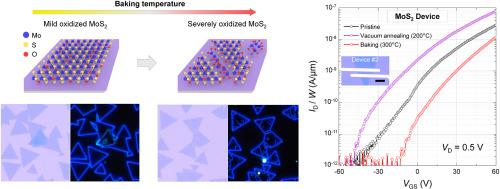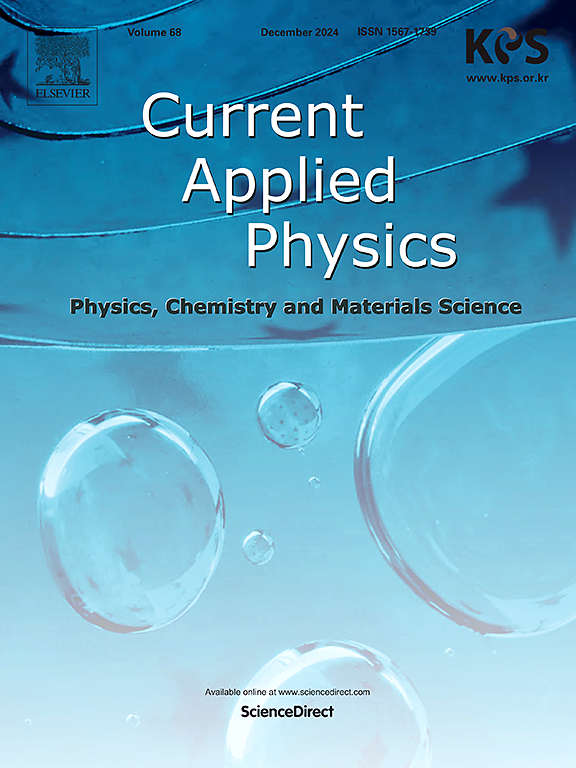Oxidation effects on the optical and electrical properties of MoS2 under controlled baking temperatures
IF 2.4
4区 物理与天体物理
Q3 MATERIALS SCIENCE, MULTIDISCIPLINARY
引用次数: 0
Abstract
As silicon-based semiconductor technology scales down to the nanoscale, it encounters significant physical limitations, including reduced electron mobility, short-channel effects, and increased heat generation, which hinder device performance and reliability. Two-dimensional (2D) semiconductors, such as molybdenum disulfide (MoS2), offer great potential with superior electrical properties at the nanoscale, but the issue of excessive heat generation in highly integrated circuits persists. Therefore, it is essential to investigate the thermal durability of MoS2 under various heating conditions and its impact on physical properties and device performance. In this study, we systematically investigated the oxidation behavior and related physical property variations of CVD-grown MoS2 monolayers by baking them at different temperatures. It was clearly revealed that high-temperature baking induces p-doping and structural deformation, significantly altering optical and electrical properties. Despite the degradation in device performance, reduced interfacial Coulomb scattering was observed, suggesting potential for improved device stability. This study underscores the importance of understanding thermal stability to accelerate the development of 2D semiconductors for next-generation electronic devices.

受控烘烤温度下氧化对 MoS2 光学和电学特性的影响
当硅基半导体技术缩小到纳米尺度时,它遇到了很大的物理限制,包括电子迁移率降低、短沟道效应和发热量增加,这些都阻碍了器件的性能和可靠性。二维(2D)半导体,如二硫化钼(MoS2),在纳米尺度上具有卓越的电学特性,具有巨大的潜力,但在高度集成电路中产生过多热量的问题依然存在。因此,研究 MoS2 在各种加热条件下的热耐久性及其对物理性质和器件性能的影响至关重要。在本研究中,我们通过在不同温度下烘烤 CVD 生长的 MoS2 单层,系统地研究了它们的氧化行为和相关物理性质变化。研究清楚地表明,高温烘烤会诱导 p 掺杂和结构变形,显著改变光学和电学特性。尽管器件性能下降,但观察到界面库仑散射减少,这表明器件稳定性有可能提高。这项研究强调了了解热稳定性对于加速开发用于下一代电子器件的二维半导体的重要性。
本文章由计算机程序翻译,如有差异,请以英文原文为准。
求助全文
约1分钟内获得全文
求助全文
来源期刊

Current Applied Physics
物理-材料科学:综合
CiteScore
4.80
自引率
0.00%
发文量
213
审稿时长
33 days
期刊介绍:
Current Applied Physics (Curr. Appl. Phys.) is a monthly published international journal covering all the fields of applied science investigating the physics of the advanced materials for future applications.
Other areas covered: Experimental and theoretical aspects of advanced materials and devices dealing with synthesis or structural chemistry, physical and electronic properties, photonics, engineering applications, and uniquely pertinent measurement or analytical techniques.
Current Applied Physics, published since 2001, covers physics, chemistry and materials science, including bio-materials, with their engineering aspects. It is a truly interdisciplinary journal opening a forum for scientists of all related fields, a unique point of the journal discriminating it from other worldwide and/or Pacific Rim applied physics journals.
Regular research papers, letters and review articles with contents meeting the scope of the journal will be considered for publication after peer review.
The Journal is owned by the Korean Physical Society.
 求助内容:
求助内容: 应助结果提醒方式:
应助结果提醒方式:


